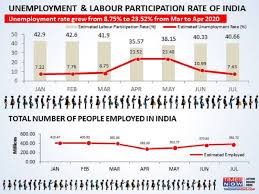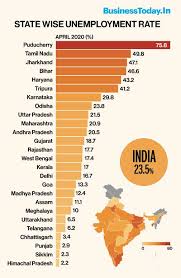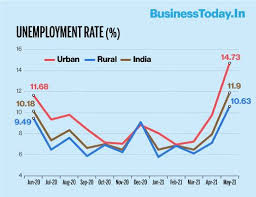India Employment Report 2024 (ILO) [Download PDF]
India Employment Report 2024: International Labor Organisation (ILO)
Youth Employment, Education & Skills
The India Employment Report 2024, released by the International Labor Organisation (ILO) in March 2024, presents the current status of employment in India, significant findings of which are presented below:
Major Findings
- Employment conditions have improved slowly over the years but deteriorated after 2019 due to the COVID-19 pandemic. Most employment remains informal with low wages.
- There was a steady workforce shift from agriculture to non-farm sectors like construction and services till 2019. However, this reversed after 2019, with a rise in agricultural employment.
- Nearly two-thirds of new employment after 2019 was self-employment and unpaid family work, mainly among women.
- Youth unemployment increased till 2019, especially among the educated, but declined during the pandemic years as educated youth took up low-skill jobs.
- One in three youths, mainly young women, were not in education, employment, or training in 2022.
- Returns to education are low at lower levels. Highly educated youth get better quality jobs, but many are overqualified for the jobs they get.
- Regional disparities persist, with poorer states faring worse in youth employment outcomes.
- Despite efforts, skills training participation remains limited, with issues like low inclusion of marginalized groups.
Implications for India
- We must create more productive non-farm jobs, especially in manufacturing, to absorb the rising workforce and unemployed youth.
- Focus on improving the quality of jobs by regulating emerging sectors like care, the digital economy etc.
- Promote women’s labor force participation through enabling policies on safety, transportation, childcare etc.
- Improve education quality at all levels and mainstream vocational training to enhance youth employability.
- Address regional disparities through targeted policies benefiting poorer states.
- Expand quality skills training programs focused on marginalized groups and demand-driven curriculum.
- Strengthen labor market information systems to understand emerging job trends better.
In essence, concerted efforts are needed to create productive employment opportunities aligned with changing labor market dynamics while improving employability through quality education and skills training, especially for marginalized youth.
Employment trends and current scenario
- Labour market indicators showed long-term deterioration between 2000 and 2019 but improved after that, coinciding with periods of economic distress.
- Despite improvements, employment conditions remained poor, with a reversal in the slow transition to non-farm employment after 2019.
Wages and earnings
- Overall, wages have remained low, with a significant percentage of unskilled workers not receiving minimum wages.
- Production has become more capital-intensive and labor-saving, leading to stagnant or declining earnings.
Growth and employment
- Employment growth remained stagnant until 2019, intensified during the COVID-19 pandemic, and saw a reverse transition from low-productivity agriculture to non-agriculture sectors.
- The service sector has been the primary driver of India’s growth since 2000, with modern services contributing to creating more productive and decent employment.
Disparities in the labor markets
- Significant variations in employment outcomes were observed across states, with disparities reflected in labor market indicators.
- Regional imbalance in migration patterns was evident, with migration rates expected to increase, particularly from eastern and northern regions to southern, western, and northern areas.
Transition in industrial employment
- The skill intensity of employment in industry and services increased, contrary to the country’s labor market needs.
- The introduction of digitally mediated gig and platform work expanded, characterized mainly by informal work with minimal social security provisions.
Future outlook
- Migration levels in India are expected to increase considerably, contributing to urban population growth with regional imbalances in migration patterns.
Employment condition index
- The index showed improvements in labor market outcomes across states, albeit at different rates, with little change in states’ position at the bottom and top.
- States such as Bihar, Uttar Pradesh, Odisha, Madhya Pradesh, Jharkhand, and Chhattisgarh had much poorer employment outcomes, with little change over time.
Future employment prospects
- Employment in the service sector exhibited consistent growth, particularly in software, IT, IT-enabled services, business, and financial services, generating highly paid, regular formal job opportunities.
- The manufacturing sector saw sluggish employment growth despite robust gross value-added growth, with a significant portion of additional employment in regular and self-employment types with higher earnings and productivity.
Structural Transformation
- Construction and services sectors have grown, while manufacturing has remained stagnant at 12-14 percent.
- India experienced a unique growth pattern, with a substantial rise in agricultural employment after 2019.
Youth Employment and Demographic Dividend
- India is at a demographic inflection point, with a decline in the youth population expected by 2036.
- Around 7-8 million persons are added to the labour force annually, potentially leading to a demographic dividend.
Youth Labor Force Participation and Unemployment
- The youth labor force participation rate increased after 2019, with a decline in unemployment rates.
Youth Employment Quality
- Employed youths are more likely to be in vulnerable occupations or the informal sector.
- Youth wages and earnings are lower than those of adults for all categories of employment.
Education and Youth Unemployment
- The unemployment rate among educated youths is significantly higher than that among those with lower levels of education.
Young Women Employment and Education
- Young women are more likely to engage in agriculture than young men.
- One in three young people in India is not employed, educated, or trained.
Youth Employment during the Pandemic
- Youth labor market indicators worsened during peak periods of the pandemic but recovered quickly post-lockdowns.
- Young workers engaged in regular salaried jobs declined during the pandemic.
Regional Variation and Education
- Regional youth employment outcomes vary across states, with disparities in potential demographic advantage and employment outcomes.
- Disparities in educational attainment persist among different segments of youth.
Education and Employment
- Highly educated youths are more likely to be employed in regular salaried jobs.
- Youths with technical degrees are predominantly in regular or formal employment.
Sectoral Employment Patterns
- Highly educated youths tend to engage more in the tertiary sector.
- Less educated youths are often found in primary and secondary sectors.
Employment Probability and Factors
- Chances of employment decrease with higher education.
- Employment likelihood increases with age, residence in rural areas, and higher expenditure quintiles.
Youth Job Aspirations
- Educated youths aspire to stable white-collar jobs.
- Societal pressures lead many young women to opt out of the labor force.
Skill Development and Labor Market Policies
- Skills training and ALMPs complement each other in addressing skills gaps.
- Expansion of skills training faces challenges like lack of uptake and spatial imbalances.
Entrepreneurship and Job Assistance
- The fresh stimulus for entrepreneurship development is crucial for job creation.
- Digitalization enables job assistance programs like the ASEEM portal.
Policy Recommendations for Employment Intensity
- Focus on making production and growth more employment-intensive.
- Invest in sectors like care and the digital economy to improve job quality.
Urbanization and Migration Policy
- An inclusive urban policy is needed to address the needs of migrating youths.
- Mission 2 aims to strengthen job quality and urbanization policies.
Boosting Women’s Participation in the Labour Market
- Craft policies that promote women’s participation with quality work and support services.
- Enhance workplace safety and provide adaptable work arrangements and improved amenities.
Improving Education Quality and Skills Training
- Augment quality education at all levels for socially and economically disadvantaged groups.
- Implement inclusive education policies to enhance employability and address skill gaps.
Enhancing Skills Training and Labour Market Policies
- Encourage state-private sector partnerships for practical skills development and an inclusive labour market.
- Facilitate marginalized youths’ access to job opportunities and address public sector job vacancies.
Frequently Asked Questions (FAQs)
Q1. What are the major challenges in youth employment highlighted in the report?
A1. The report highlights rising youth unemployment till 2019, low-quality informal jobs, lack of employment opportunities for educated youth, gender gaps with many young women remaining outside the workforce, and regional disparities in employment outcomes across states.
Q2. What recommendations does the report make to improve the employment scenario?
A2. Key recommendations include integrating employment objectives in economic policies, promoting labor-intensive manufacturing, improving the quality of jobs, enabling women’s workforce participation, enhancing education and skills training, addressing regional inequalities, and bridging data gaps.
Q3. According to the report, how can skills development programs be made more effective?
A3. The report suggests greater targeting of marginalized groups, stronger partnerships with industry, expanding quality vocational training integrated with formal education, and facilitating effective job matching through career counselling and job search assistance.
Q4. What are the implications of the report’s findings for policymakers?
A4. Policymakers must prioritize productive employment generation aligned with changing labor market dynamics, enhance employability through quality training focused on emerging skills needs, reduce inequalities through regionally balanced and inclusive policies, and strengthen labor market information systems.
Q5. How does the report assess India’s potential to reap demographic dividends?
A5. The report highlights that while India has a large working-age population providing demographic advantages, realizing the dividends depends on creating sufficient quality employment opportunities and improving the skills and productivity of the workforce, especially youth.






